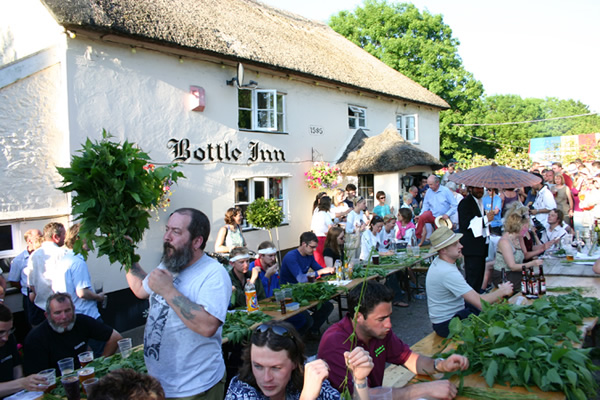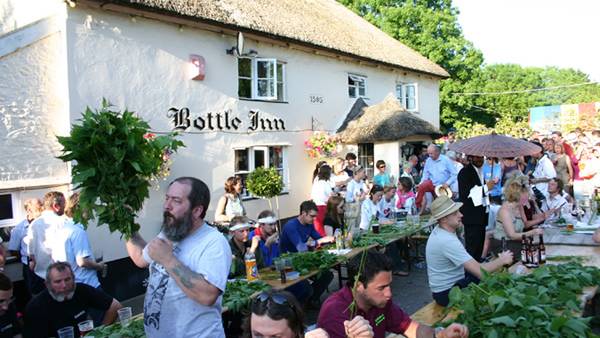The Sting of a Nettle

Stinging nettles, properly known as Urtica dioica, produce formic acid similar to ant stings, which they hold in brittle hollow hairs. When you crush a plant, you break the hairs, causing the acid to burn your skin. The sting is temporary and the pain subsides in 10 minutes or so.
The name Urtica dioica comes from the Latin uro or "I burn", what refers to the pricking character of the plant, and dioica or 2 houses that refers to the separation of the masculine and feminine plants.
The Bottle Inn at Marshwood (UK) holds an annual World Nettle-Eating Championships. Each year contestants munch their way through stinging nettle, without a dock leaf, to ease the pain, in sight.
The contest began more than 20 years ago when two customers at Marshwood’s 16th century Bottle Inn argued over who had the worst infestation of stinging nettles. One of them said,”I’ll eat any nettle of yours that’s longer than mine." And so they had a competition. Today, people from all over the world attend the Nettle-Eating Championships.
The stinging nettle plant is a nutritional powerhouse, rich in iron, potassium, calcium, magnesium, silicon, boron, and zinc. It is also an excellent source of vitamins A, D, E, and K. They have been used in traditional English stews, teas and beers for centuries, while the Italians cherish them for pesto and the Scandinavians make a knockout nettle soup called Nässelsoppa. However, the complications come with eating the things raw since the planet is covered in thousands of microscopic hypodermic needles each filled with boric acid. Crushing the leaves disable the sting so nettles can even be served in salads.
In Denmark, burial shrouds made of nettle fabrics have been discovered that date back to the Bronze Age (3000-2000 BC). Europeans and Native Americans used the fibers from stinging nettle to make sailcloth, sacking, cordage, and fishing nets. These fibers have also been used to produce cloth similar in feel and appearance to silky linen. During World War I, the German Empire, plagued by textile shortages, used nettles as a substitute for cotton. Captured German uniforms were found to be 85% nettle fiber.
Stinging nettle is one of the richest sources of chlorophyll in the vegetable kingdom. A decoction of the plant has been used to produce a green dye for clothing for centuries. At the beginning of the Second World War, a request by the British government was made for the collection of 100 tons of nettles, which were used for the extraction of this green dye for camouflage. This property has also been used commercially in Germany as a food coloring agent for canned vegetables.
In the fairytale of The Wild Swans, a princess rescues her eleven brothers from a spell cast by an evil queen by knitting nettles into shirts for them. One night the princess runs out of nettles and is forced to collect more in a nearby church graveyard where the Archbishop is watching. He reports the incident to the king as proof of witchcraft and the king orders the people to put on trial.
As a medicine, the herb and the root are used. Documentation or anecdotal reports of its use have been found among the Ecuador Indians, ancient Romans, Egyptians, Greeks, and Canadian and American native tribes.
Clinical studies have investigated its use in treating many medical conditions, including allergic rhinitis, rheumatic complaints, eczema, anemia, bleeding (both internally and externally), and acute arthritis. It is in demand as a treatment for benign prostate hyperplasia (BPH), high blood pressure and urinary tract and bacterial infections. It is used in treating skin eruptions and freeze-dried as a treatment for hay fever and allergies. Also it is a diuretic and laxative, for dog bites, gangrenous wounds, swellings, nose bleeding, excessive menstruation, spleen-related illness, pleurisy, pneumonia, asthma, tinea, mouth sores, diarrhea, blood sugar and diabetes. Nettle can be used to purify and cleanse internal organs. It truly is an incredible plant.
The rich chlorophyll in nettles will help those who lack energy. Chlorophyll is the molecule that absorbs sunlight and uses its energy to synthesize carbohydrates from CO2 and water. This process is known as photosynthesis and is the basis for sustaining the life processes of all plants. Since animals and humans obtain their food supply by eating plants, photosynthesis can be said to be the source of our life also.
Serotonin occurs in nettle, and is found to be of great benefit to many people who suffer from depression.
Apuleius Platonicus (circa 400 A.D.), in his book Herbarium of Apuleius, added nettle combined with hemp or cannabis to “treat symptoms of feeling cold after being burnt (shocked)”, and nettle by itself for “cold injury”. Throughout the Dark Ages (fifth to tenth centuries) uses of nettle were expanded to include treatment of shingles, constipation, and “dry disease”, which probably meant problems with the sinuses or lungs, mucous membranes, and skin.
The 16th century herbalist John Gerard used stinging nettle as an antidote for poison.
It has been used freely as a gynecological aid by women of the North American aboriginal nations. The juice is taken by pregnant women who are overdue to promote labor. The tips of the plant were chewed during childbirth, as well as the infusion being drunk to relax the muscles.
Stinging nettle has been used throughout history as animal fodder and as vegetarian rennet in cheese making.
Washing your hair in a nettle based shampoo is meant to be good at getting rid of dandruff.
In the garden, nettles make fantastic compost activator and fertilizer. A lidded bucketful of nettles covered in water and left to stew for a week or two produces an all purpose liquid feed of high quality. Watered down 10 to 1 it can benefit the entire garden and particularly tomatoes.
Nettle can be taken in a capsule, powder form, tea, tincture, topical oil, plant extract, crushed and rubbed directly onto the skin, juiced, cooked and steamed.
Stinging nettle is known as a tough plant often growing where other plants refuse to grow. It can also be found growing around houses, barns, fences, and other well fertilized areas. Nettles are known to blossom throughout most of the year in the milder climate areas.
The English poet, Campbell, complained of the little attention paid to the nettle in England. He says, “In Scotland, I have eaten nettles, I have slept in nettle sheets, and I have dined off a nettle tablecloth. The young and tender nettle is an excellent potherb. The stalks of the old nettle are as good as flax for making cloth. I have heard my mother say that she thought nettle cloth more durable than any other species of linen.” Tell that to The Bottle Inn at Marshwood!
"Leaders grasp nettles." – David Ogilvy
There’s a Swedish proverb that says, "Love is like dew that falls on both nettles and lilies."
"He who is afraid of every nettle should not piss in the grass. - Thomas Fuller
More health articles






















